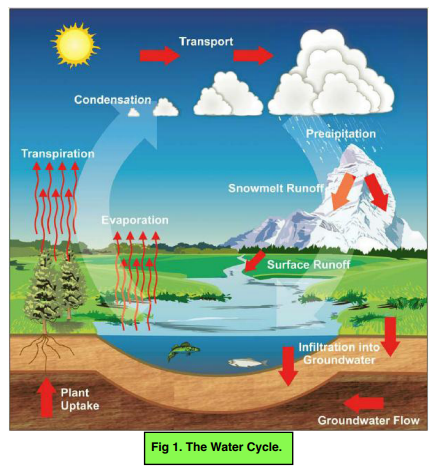Cycles - The Water Cycle (GCSE Biology)
The Water Cycle
The Water Cycle
The water cycle is used to move water through the ecosystem. The water we drink is the same water that existed even in Jurassic times. It is cycled through the environment. This is important because all living organisms need water to survive and if water wasn’t recycled, then the earth would run out of it.

As it is a cycle, we can begin at any point. Therefore, we shall begin in the lakes, oceans and trees.
- Transpiration. We discussed the transpiration stream previously. This works to send water taken in by the roots of the plants back into the atmosphere as water vapour.
- Evaporation. Water evaporates, changing state from liquid to gas, from bodies of water, such as lakes and oceans and ponds. Light energy from the sun causes this.
- Condensation. After evaporation and transpiration, the water vapour cools, forming liquid clouds.
- Transport. When liquid clouds are formed, they can be pushed far distances by wind.
- Precipitation. Rain, snow, sleet and hail fall from the clouds into the bodies of water and the land.
- Surface runoff. Sometimes, when there is a large amount of precipitation, water runs along the earth to enter bodies of water.
- Infiltration. Some water that falls is absorbed into the ground. It can then be stored in aquifers. These are underground, permeable rocks.
The process then cycles.
Droughts and Desalination
A drought is when there isn’t enough precipitation taking place.
This can be very problematic as we rely on water from precipitation for drinking. Sea water isn’t suitable to drink directly because it is too salty.
A solution to this is producing portable water for example, through the process of desalination:
- Desalination is the process of removing salts from salty water. Sea water is salty so it can be desalinated so it is suitable to drink.
- Thermal desalination uses evaporation. In an enclosed vessel, salty water is heated till it boils and evaporates. The salt remains at the bottom and the steam rises to the top and travels down a tube where it condenses. This water is now pure.
- A modern desalination method is reverse osmosis. This involves the water being treated to remove debris and solids. Water is then piped into a vessel with a partially-permeable membrane and high pressure. This forces water to move from the salty water side to the pure water side with the salts being left behind (as they can’t pass the partially permeable membrane).
The water cycle in GCSE Biology, also known as the hydrologic cycle, is the continuous movement of water on, above, and below the Earth’s surface. It involves a series of processes including evaporation, transpiration, precipitation, and infiltration.
The water cycle in GCSE Biology consists of four main stages:
Evaporation: This is the process by which water changes from a liquid state to a gaseous state, as it is heated by the sun and rises into the atmosphere.
Transpiration: This is the process by which water is released from plants into the atmosphere, adding to the amount of water vapor in the air.
Precipitation: This is the process by which water falls from the atmosphere to the ground as rain, snow, hail, or sleet.
Infiltration: This is the process by which water seeps into the ground, replenishing the groundwater supplies.
The water cycle in GCSE Biology plays a critical role in the Earth’s climate by regulating temperature and controlling the distribution of water. The process of evaporation helps to cool the Earth, while the release of water vapor into the atmosphere contributes to the greenhouse effect, which helps to regulate the temperature of the planet.
Human activity can have significant consequences on the water cycle in GCSE Biology, including:
Deforestation: Clearing large areas of forests can reduce the amount of transpiration and increase the amount of evaporation, leading to a change in the water cycle.
Climate change: Changes in the Earth’s temperature due to human activities such as burning fossil fuels and deforestation can impact the water cycle by altering patterns of precipitation and evaporation.
Water pollution: The release of pollutants into the water cycle can negatively impact water quality and limit its availability for human and ecological use.
To preserve the water cycle in GCSE Biology, there are several actions that can be taken, including:
Protecting forests: Maintaining and protecting forests can help to regulate the water cycle by increasing the amount of transpiration.
Reducing greenhouse gas emissions: Reducing emissions of greenhouse gases such as carbon dioxide can help to mitigate the impacts of climate change on the water cycle.
Preventing water pollution: Taking steps to prevent water pollution, such as controlling agricultural runoff and properly disposing of waste, can help to maintain the quality of water in the water cycle.






Still got a question? Leave a comment
Leave a comment